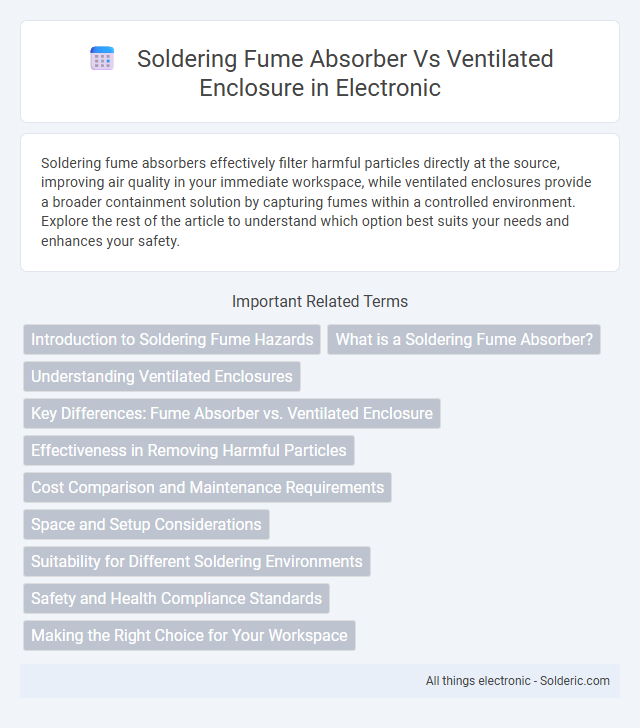Soldering fume absorbers effectively filter harmful particles directly at the source, improving air quality in your immediate workspace, while ventilated enclosures provide a broader containment solution by capturing fumes within a controlled environment. Explore the rest of the article to understand which option best suits your needs and enhances your safety.
Comparison Table
| Feature | Soldering Fume Absorber | Ventilated Enclosure |
|---|---|---|
| Primary Function | Removes harmful soldering fumes at the source | Contains fumes within an enclosed space and vents them out |
| Filtration | Uses activated carbon and HEPA filters | Relies on external ventilation systems or exhaust ducts |
| Portability | Compact and portable units available | Typically stationary, fixed installation |
| Installation | Easy plug-and-play setup | Requires professional installation and ducting |
| Noise Level | Low to moderate noise from fans | Varies based on ventilation system |
| Maintenance | Periodic filter replacement | Regular duct cleaning and system checks |
| Cost | Lower initial cost; filter replacement ongoing | Higher setup cost; lower ongoing maintenance |
| Effectiveness | Efficient at capturing smoke and fumes locally | Effective for larger workspaces and better containment |
Introduction to Soldering Fume Hazards
Soldering fume absorbers effectively capture and filter hazardous fumes directly at the source, reducing worker exposure to toxic metallurgical particles and flux vapors. Ventilated enclosures use airflow systems to contain and exhaust soldering fumes, preventing dispersion into the workspace but requiring proper maintenance to ensure efficiency. Both solutions address the critical health risks associated with inhaling volatile organic compounds and particulate matter generated during soldering processes.
What is a Soldering Fume Absorber?
A soldering fume absorber is a specialized device designed to capture and filter harmful fumes generated during soldering processes, protecting workers from toxic substances like lead, flux vapors, and smoke particles. Unlike ventilated enclosures that rely on airflow and external ventilation systems, fume absorbers use advanced filtration technologies such as activated carbon filters or HEPA filters to purify the air directly at the source. Your work environment's safety improves significantly when using a soldering fume absorber, as it efficiently removes hazardous contaminants and reduces exposure risks.
Understanding Ventilated Enclosures
Ventilated enclosures provide a controlled environment that captures soldering fumes at their source, ensuring effective removal and reducing airborne contaminants. These enclosures use built-in filtration or external ventilation systems to protect workers from hazardous exposure during soldering. Your choice between a soldering fume absorber and a ventilated enclosure depends on the workspace setup and the level of fume containment required.
Key Differences: Fume Absorber vs. Ventilated Enclosure
A soldering fume absorber captures and filters hazardous fumes directly at the source using specialized filters, ensuring cleaner air immediately around your workspace. In contrast, a ventilated enclosure isolates the soldering area within a contained space, using an external ventilation system to remove fumes from the environment entirely. Choosing between these depends on your workspace needs: fume absorbers offer portability and targeted filtration, while ventilated enclosures provide comprehensive containment but require more space and installation.
Effectiveness in Removing Harmful Particles
Soldering fume absorbers use high-efficiency particulate air (HEPA) filters combined with activated carbon to capture and neutralize harmful particles and gases produced during soldering, offering targeted removal at the source. Ventilated enclosures rely on airflow systems to contain and exhaust fumes, which can reduce exposure but may be less efficient in filtering fine particulate matter without specialized filtration components. Overall, fume absorbers generally provide superior effectiveness in removing both particulate and gaseous contaminants compared to ventilated enclosures.
Cost Comparison and Maintenance Requirements
Soldering fume absorbers generally have a lower initial cost compared to ventilated enclosures, making them more accessible for small workshops or individual use. Maintenance for fume absorbers involves regularly replacing or cleaning filters, which is straightforward but crucial to sustaining performance and air quality. Ventilated enclosures require a higher upfront investment and periodic inspections of ventilation systems, ductwork, and airflow efficiency, leading to increased long-term maintenance costs but providing comprehensive fume containment and removal.
Space and Setup Considerations
Soldering fume absorbers are compact and require minimal space, making them ideal for small workstations or portable setups. Ventilated enclosures, however, demand larger footprint and dedicated installation areas to accommodate ducting and airflow systems. Selecting between them depends on available workspace, with absorbers favoring limited space and enclosures suited for fixed, spacious environments.
Suitability for Different Soldering Environments
Soldering fume absorbers are ideal for small-scale or portable workstations where localized extraction is needed to quickly remove hazardous fumes. Ventilated enclosures provide comprehensive containment and air filtration, making them more suitable for industrial or high-volume soldering operations requiring stringent safety standards. The choice depends on the workspace size, soldering frequency, and required air quality control level.
Safety and Health Compliance Standards
Soldering fume absorbers effectively capture and filter hazardous particles and gases directly at the source, ensuring compliance with OSHA and REACH safety standards for workplace air quality. Ventilated enclosures, designed with controlled airflow systems, meet ISO and ANSI regulations by containing fumes within a confined space, minimizing exposure risks. Your choice should align with specific health regulations and operational needs to maintain a safe working environment and reduce occupational respiratory hazards.
Making the Right Choice for Your Workspace
Choosing between a soldering fume absorber and a ventilated enclosure depends on workspace size and fume volume. Soldering fume absorbers offer portability and localized filtration ideal for small to medium setups, while ventilated enclosures provide comprehensive containment and extraction suitable for high-volume or sensitive environments. Prioritizing efficiency, safety standards, and maintenance requirements ensures optimal air quality and compliance in your workspace.
soldering fume absorber vs ventilated enclosure Infographic

 solderic.com
solderic.com